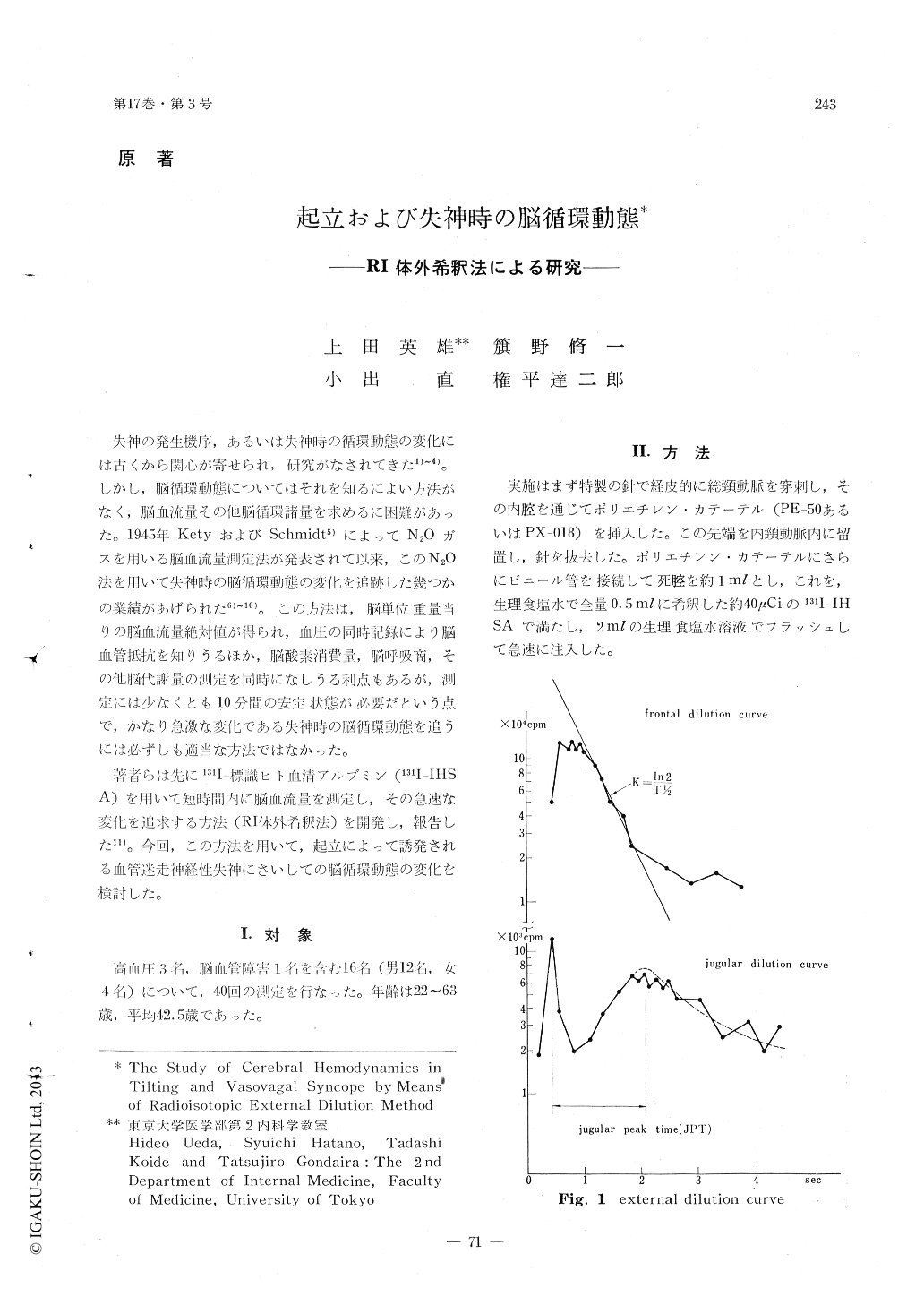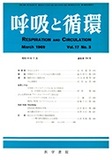Japanese
English
- 有料閲覧
- Abstract 文献概要
- 1ページ目 Look Inside
失神の発生機序,あるいは失神時の循環動態の変化には古くから関心が寄せられ,研究がなされてきた1)〜4)。しかし,脳循環動態についてはそれを知るによい方法がなく,脳血流量その他脳循環諸量を求めるに困難があった。1945年KetyおよびSchmidt5)によってN2Oガスを用いる脳血流量測定法が発表されて以来,このN2O法を用いて失神時の脳循環動態の変化を追跡した幾つかの業績があげられた6)〜10)。この方法は,脳単位重量当りの脳血流量絶対値が得られ,血圧の同時記録により脳血管抵抗を知りうるほか,脳酸素消費量,脳呼吸商,その他脳代謝量の測定を同時になしうる利点もあるが,測定には少なくとも10分間の安定状態が必要だという点で,かなり急激な変化である失神時の脳循環動態を追うには必ずしも適当な方法ではなかった。
著者は先に131I—標識ヒト血清アルブミン(131I-IHSA)を用いて短時間内に脳血流量を測定し,その急速な変化を追求する方法(RI体外希釈法)を開発し,報告した11)。今回,この方法を用いて,起立によって誘発される血管迷走神経性失神にさいしての脳循環動態の変化を検討した。
Cerebral hemodynamics in tilting and vas- ovagal syncope was studied by means of external dilution method using radioactive iodicd human serum albumin (I-131 IHSA) that we reported previously. Comparing with the other methods, our method has the advantage to be able to measure the flow in short time -in about 20 seconds. This advantage was valid in studying a rapid change such as in cerebral hemodynamics in vasovagal syncope.
We had 40 measurements in 16 subjects of 42.5 years old in the mean, containing of three with hypertension and one with cere-brovascural disease.
I-131 IHSA was rapidly injected into the internal carotid artery. Radioactivity was counted simultaneously both over frontal and over jugular regions by scintillation detectors with narrow angle collimaters. The change of counting rate was recorded on the semi-logarithmic paper and both frontal and jugular dilution curves were obtained.
Two factors were used as the index re presenting cerebral hemodynamics; one was the slope (K) of frontal dilution curve and the other was the time (jugular peak time, JPT) between 2 peaks of jugular dilution curve. The former was regarded as the fac-tor of cerebral blood flow and the later was regarded as that of cerebral circulation time. Systemic blood pressure and pulse rate were measured at the same time.
The measurements were performed at first on supine position and then on tilting posi-tion. In five cases cerebral hemodynamics was measured during the vasovagal syncope that occurred by tilting. The frontal K de-creased from 0.438±0.092 (S. D.) at supine position to 0.379±0.080 (S. D.) at tilting position. JPT increased simultaneously from 6.5±1.5 (S. D. ) sec to 7.2±1.7 (S. D. ) sec. Blood pressure and pulse rate showed little change at that time. When the values in vasovagal syncope were compared with those of supine position, the frontal K decreased from 0.418±0.010 (S.D.) to 0.219±0.067 (S. D.) and JPT increased from 6.4±1.1 (S. D.) sec to 13.8±3.0 (S. D. ) sec. Systolic blood pressure decreased from 121.6 mmHg to 69.0 mmHg.
On these studies cerebral hemodynamics showed little changes by tilting. It was thought that the steadiness of cerebral hemo-dynamics was not owing to the primary autoregulation of the cerebral vessels but to the mechanism maintaining blood pressure. On the other hand cerebral blood flow decreased and JPT increased markedly in vasovagal syncope. At that time systemic blood pres-sure decreased and was often unmeasurarable. We consider that blood pressure played the main role in the control of cerebral hemody-namics in tilting and that vasovagal syncope occurred by breaking out the neurogenic control of blood pressure.

Copyright © 1969, Igaku-Shoin Ltd. All rights reserved.


